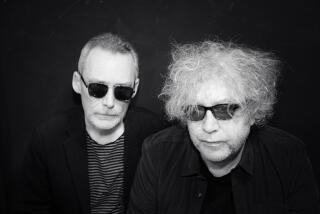Lou Reed dies at 71; rock giant led the Velvet Underground
Like many unhappy teenagers, Lou Reed found more than a measure of solace in music.
“Listening to the radio absolutely transformed me,” he told The Times in 1992. “It was like a huge, major-league signal that there was another world, another life out there … that everything wasn’t as horrible as where I was.”
A giant of rock, Reed sent the same message — as deafeningly harsh as it often was — to generations of punk aficionados and mainstream fans for nearly 50 years. The guitarist whose dark vision colored music for decades and whose 1960s group the Velvet Underground inspired musicians around the world, died Sunday in Southampton, N.Y., according to his literary agent Andrew Wylie.
Reed, 71, died of complications from a May liver transplant, Wylie said. In March, Reed had canceled his scheduled appearance at the Coachella Valley Music and Arts Festival in Indio.
First as the Velvet Underground’s principal songwriter and then as a solo artist, Reed continued to challenge musical and cultural conventions, becoming a pioneer of what came to be known as art rock and punk rock. Summing up Reed’s influence, music producer Brian Eno once said that although the Velvet Underground sold only 30,000 copies of its debut album in five years, “everyone who bought one of those 30,000 copies started a band.”
On Sunday, Greg Harris, president of the Rock and Roll Hall of Fame, said in a statement that Reed “cultivated a singular musical aesthetic that managed to be both arty and earthy, reflecting his college-educated yet streetwise-honed rock and roll narratives.”
His work “provided the framework for generations of artists,” Harris said, including Patti Smith, the Sex Pistols, Talking Heads, R.E.M. and U2.
Reed was inducted into the Cleveland-based Rock and Roll Hall of Fame in 1996, well after he was established as a global figure. Vaclav Havel, the writer and Czech president who led the 1989 uprising known as the Velvet Revolution, extolled Reed and hosted him in Prague. In 1998, at Havel’s request, Reed performed at a White House dinner in Havel’s honor.
Although cutting edge, Reed was credited with “introducing avant-garde rock to the mainstream,” Neil Portnow, president and chief executive of the Recording Academy, an industry group, said Sunday. “His uniquely stripped-down style of guitar playing and poetic lyrics have had a massive influence across many rock genres.”
Reed reveled in his music’s simplicity.
“One chord is fine,” he once said. “Two chords are pushing it. Three chords and you’re into jazz.”
A sonic assault was as important to Reed as his emotionally raw lyrics, and fans delighted in both.
“I met Lou Reed and told him he gave me tinnitus at a concert in 1989 that never went away and it was worth it,” comedy star Judd Apatow tweeted Sunday.
John Cale, the Velvet Underground’s original keyboardist and viola player, on Sunday called Reed “a fine songwriter and poet.”
“I’ve lost my ‘school-yard buddy,’” he said in a Twitter message.
Born in Brooklyn, N.Y., on March 2, 1942, the son of accountant Sidney Reed and his wife, Toby, Reed grew up in the Long Island suburb of Freeport.
It wasn’t a happy childhood for him or his family.
“Tyrannically presiding over their middle-class home, he slashed screeching chords on his electric guitar, practiced an effeminate way of walking, drew his sister aside in conspiratorial conferences and threatened to throw the mother of all moodies if everyone didn’t pay complete attention to him,” Victor Bockris wrote in his 1995 Reed biography, “Transformer.”
When Reed was 17, his parents sent him to a psychiatric hospital where he was given 24 rounds of electroconvulsive therapy to curb his homosexual tendencies. Years later, in 1974, he released a song about the ordeal called “Kill Your Sons,” a harsh condemnation of “two-bit psychiatrists” and a clueless family.
“They’re gonna kill, kill your sons,” he wrote, “until they run, run, run, run, run, run, run, run away.”
In high school and at Syracuse University, he played rhythm guitar in bands, performing upbeat campus staples like “Twist and Shout.” At the same time, he was cultivating the darker artist within, devouring the urban underworld stories of Hubert Selby Jr. and cementing a lifelong friendship with Syracuse instructor Delmore Schwartz, a talented poet who struggled with mental illness for decades.
Graduating from Syracuse with a bachelor’s degree in English in 1964, Reed headed for New York City. The following year, he first performed with Cale, guitarist Sterling Morrison and drummer Maureen “Moe” Tucker — a provocative bunch who came to call themselves the Velvet Underground.
The idea was to be exactly what the mid-’60s were not. The Velvet Underground aimed to rip the petals off flower power and focus on grimmer urban landscapes. It would not play blues or indulge in the popular R&B licks of the day, Reed vowed.
“This is going to be city,” he said, reminiscing about the group’s origin, at the 2008 South by Southwest music conference in Austin, Texas. “This is going to be pure.”
The group’s 1967 debut album, “The Velvet Underground and Nico,” showcased “Heroin,” an ode to the drug by a user who sang that being high made him “better off than dead”:
When the smack begins to flow
Then I really don’t care anymore
About all the Jim-Jims in this town
And all the politicians makin’ crazy sounds
And everybody puttin’ everybody else down
And all the dead bodies piled up in mounds
At the time, such subjects were off limits for song writers, Robert Hilburn, The Times’ former rock critic, said Sunday.
Reed “talked about heroin and illicit sex at a time when the music industry didn’t want to hear it,” Hilburn said. “Critics loved him, but it took him years and years to find an audience.”
The pop artist Andy Warhol was a fan almost immediately. He made the Velvet Underground his studio’s house band and gave the group a front-and-center position in his series of multimedia events called Exploding Plastic Inevitable.
By the time the Velvet Underground dissolved in 1970, the group had released four albums and recorded enough material for the release of two others in the mid-1980s. Its best-known songs include “Sweet Jane” and “I’m Waiting for the Man.”
As a solo performer in the 1970s, Reed had a distinctive persona.
“Back then he was publicly gay, pretended to shoot heroin onstage, and cultivated a ‘Dachau panda’ look, with cropped peroxide hair and black circles painted under his eyes,” the New York Times reported in 1998. “But in 1980, Reed renounced druggy theatrics, even swore off intoxicants themselves, and became openly heterosexual, openly married.”
Along the way, he tested even his most stalwart fans with the 1975 double album “Metal Machine Music,” a compilation of guitar noise that has been called “one of the most perverse recordings of the modern era, at least by a mainstream artist.”
Reed also had a number of smash hits on his own. In his 1972 album “Transformer,” produced with David Bowie, he sang his famous “Walk on the Wild Side,” an anthem to a variety of sexual experiences.
In the heat of the 1996 presidential campaign, he released “Sex With Your Parents,” a song aiming “to mock and ridicule the right-wing Republican fundamentalists who are so abhorrent to every principle of freedom of expression.”
His most recently released recorded work was “Lulu,” a 2011 collaboration with the heavy metal act Metallica.
Reed was divorced twice. He is survived by his wife, performance artist Laurie Anderson, whom he married in 2008.
Times staff writers Todd Martens and Jessica Gelt contributed to this report.
More to Read
Start your day right
Sign up for Essential California for the L.A. Times biggest news, features and recommendations in your inbox six days a week.
You may occasionally receive promotional content from the Los Angeles Times.







